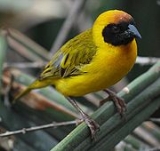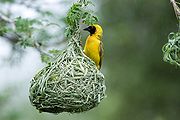
Southern Masked-Weaver
Encyclopedia
The Southern Masked Weaver or African Masked Weaver (Ploceus velatus) is a resident breeding bird
species common throughout southern Africa
.
This weaver is very widespread and found in a wide range of habitats, including shrubland, savanna, grassland, open woodland, inland wetlands and semi-desert areas. It also occurs in suburban gardens and parks.
The female has a pinkish-brown bill, brown or red-brown eye and is dull greenish-yellow, streaked darker on the upper back. The throat is yellowish, fading to off-white on the belly. The non-breeding male resembles the female but retains the red eye. The juvenile of this species is like the female.
The call is a harsh swizzling, similar to other weavers. It also utters a sharp chuk alarm note.

The Southern Masked Weaver lays eggs of a various colour and this helps it to evade parasitisation by cuckoos because the cuckoo has no way of knowing what kind of eggs are inside the weaver's nest until it has entered the nest to attempt to lay one itself. Eggs of the wrong colouration are ejected by the nest owners.
Bird
Birds are feathered, winged, bipedal, endothermic , egg-laying, vertebrate animals. Around 10,000 living species and 188 families makes them the most speciose class of tetrapod vertebrates. They inhabit ecosystems across the globe, from the Arctic to the Antarctic. Extant birds range in size from...
species common throughout southern Africa
Africa
Africa is the world's second largest and second most populous continent, after Asia. At about 30.2 million km² including adjacent islands, it covers 6% of the Earth's total surface area and 20.4% of the total land area...
.
This weaver is very widespread and found in a wide range of habitats, including shrubland, savanna, grassland, open woodland, inland wetlands and semi-desert areas. It also occurs in suburban gardens and parks.
Description
The Southern Masked Weaver is 11-14.5 cm long with a short, strong, conical bill and pinkish brown legs. The adult male in breeding plumage has a black face, throat and beak, red eye, bright yellow head and underparts, and a plain yellowish-green back,The female has a pinkish-brown bill, brown or red-brown eye and is dull greenish-yellow, streaked darker on the upper back. The throat is yellowish, fading to off-white on the belly. The non-breeding male resembles the female but retains the red eye. The juvenile of this species is like the female.
The call is a harsh swizzling, similar to other weavers. It also utters a sharp chuk alarm note.

Breeding
The Southern Masked Weaver nests in colonies, mainly from September to January. Males have several female partners, and build a succession of nests, typically 25 each season. The nests, like those of other weavers, are woven from reed, palm or grass. A female will line a selected nest with soft grass and feathers. The nest is built in a tree, often over water, but sometimes in suburbia. his weaver also nests in reeds.The Southern Masked Weaver lays eggs of a various colour and this helps it to evade parasitisation by cuckoos because the cuckoo has no way of knowing what kind of eggs are inside the weaver's nest until it has entered the nest to attempt to lay one itself. Eggs of the wrong colouration are ejected by the nest owners.

